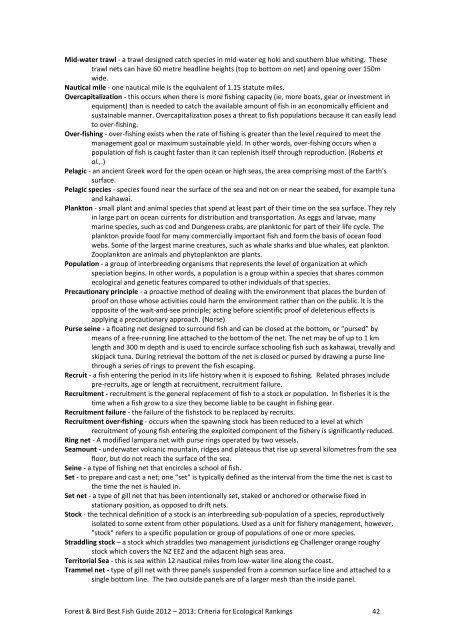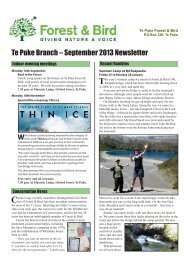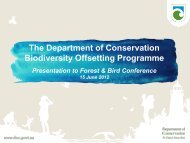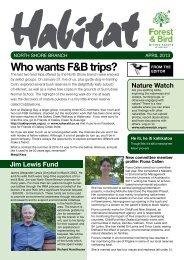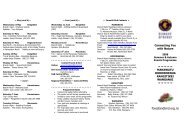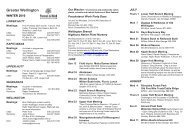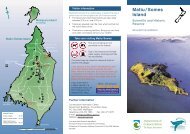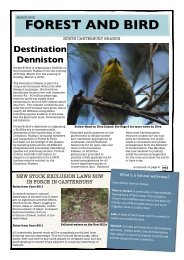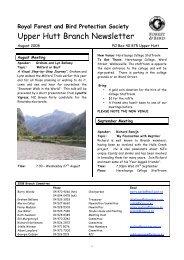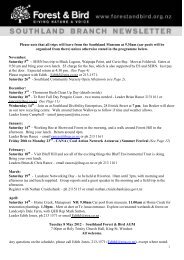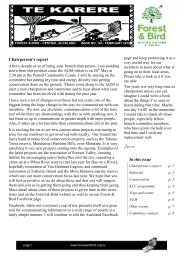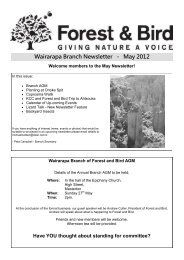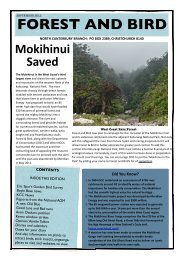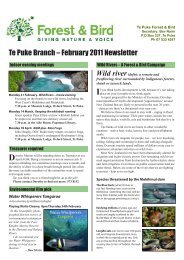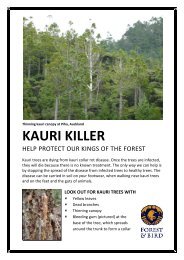methodology - Forest and Bird
methodology - Forest and Bird
methodology - Forest and Bird
Create successful ePaper yourself
Turn your PDF publications into a flip-book with our unique Google optimized e-Paper software.
Mid-water trawl - a trawl designed catch species in mid-water eg hoki <strong>and</strong> southern blue whiting. These<br />
trawl nets can have 60 metre headline heights (top to bottom on net) <strong>and</strong> opening over 150m<br />
wide.<br />
Nautical mile - one nautical mile is the equivalent of 1.15 statute miles.<br />
Overcapitalization - this occurs when there is more fishing capacity (ie, more boats, gear or investment in<br />
equipment) than is needed to catch the available amount of fish in an economically efficient <strong>and</strong><br />
sustainable manner. Overcapitalization poses a threat to fish populations because it can easily lead<br />
to over-fishing.<br />
Over-fishing - over-fishing exists when the rate of fishing is greater than the level required to meet the<br />
management goal or maximum sustainable yield. In other words, over-fishing occurs when a<br />
population of fish is caught faster than it can replenish itself through reproduction. (Roberts et<br />
al.,.)<br />
Pelagic - an ancient Greek word for the open ocean or high seas, the area comprising most of the Earth's<br />
surface.<br />
Pelagic species - species found near the surface of the sea <strong>and</strong> not on or near the seabed, for example tuna<br />
<strong>and</strong> kahawai.<br />
Plankton - small plant <strong>and</strong> animal species that spend at least part of their time on the sea surface. They rely<br />
in large part on ocean currents for distribution <strong>and</strong> transportation. As eggs <strong>and</strong> larvae, many<br />
marine species, such as cod <strong>and</strong> Dungeness crabs, are planktonic for part of their life cycle. The<br />
plankton provide food for many commercially important fish <strong>and</strong> form the basis of ocean food<br />
webs. Some of the largest marine creatures, such as whale sharks <strong>and</strong> blue whales, eat plankton.<br />
Zooplankton are animals <strong>and</strong> phytoplankton are plants.<br />
Population - a group of interbreeding organisms that represents the level of organization at which<br />
speciation begins. In other words, a population is a group within a species that shares common<br />
ecological <strong>and</strong> genetic features compared to other individuals of that species.<br />
Precautionary principle - a proactive method of dealing with the environment that places the burden of<br />
proof on those whose activities could harm the environment rather than on the public. It is the<br />
opposite of the wait-<strong>and</strong>-see principle; acting before scientific proof of deleterious effects is<br />
applying a precautionary approach. (Norse)<br />
Purse seine - a floating net designed to surround fish <strong>and</strong> can be closed at the bottom, or “pursed” by<br />
means of a free-running line attached to the bottom of the net. The net may be of up to 1 km<br />
length <strong>and</strong> 300 m depth <strong>and</strong> is used to encircle surface schooling fish such as kahawai, trevally <strong>and</strong><br />
skipjack tuna. During retrieval the bottom of the net is closed or pursed by drawing a purse line<br />
through a series of rings to prevent the fish escaping.<br />
Recruit - a fish entering the period in its life history when it is exposed to fishing. Related phrases include<br />
pre-recruits, age or length at recruitment, recruitment failure.<br />
Recruitment - recruitment is the general replacement of fish to a stock or population. In fisheries it is the<br />
time when a fish grow to a size they become liable to be caught in fishing gear.<br />
Recruitment failure - the failure of the fishstock to be replaced by recruits.<br />
Recruitment over-fishing - occurs when the spawning stock has been reduced to a level at which<br />
recruitment of young fish entering the exploited component of the fishery is significantly reduced.<br />
Ring net - A modified lampara net with purse rings operated by two vessels.<br />
Seamount - underwater volcanic mountain, ridges <strong>and</strong> plateaus that rise up several kilometres from the sea<br />
floor, but do not reach the surface of the sea.<br />
Seine - a type of fishing net that encircles a school of fish.<br />
Set - to prepare <strong>and</strong> cast a net; one “set” is typically defined as the interval from the time the net is cast to<br />
the time the net is hauled in.<br />
Set net - a type of gill net that has been intentionally set, staked or anchored or otherwise fixed in<br />
stationary position, as opposed to drift nets.<br />
Stock - the technical definition of a stock is an interbreeding sub-population of a species, reproductively<br />
isolated to some extent from other populations. Used as a unit for fishery management, however,<br />
"stock" refers to a specific population or group of populations of one or more species.<br />
Straddling stock – a stock which straddles two management jurisdictions eg Challenger orange roughy<br />
stock which covers the NZ EEZ <strong>and</strong> the adjacent high seas area.<br />
Territorial Sea - this is sea within 12 nautical miles from low-water line along the coast.<br />
Trammel net - type of gill net with three panels suspended from a common surface line <strong>and</strong> attached to a<br />
single bottom line. The two outside panels are of a larger mesh than the inside panel.<br />
<strong>Forest</strong> & <strong>Bird</strong> Best Fish Guide 2012 – 2013: Criteria for Ecological Rankings 42


